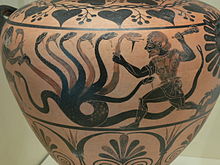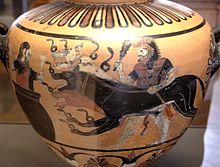Caeretan hydria
The Caeretaner Hydrien is a special style of Greek vase painting that is attributed to the black-figure style .
The Caeretaner Hydria are a particularly colorful genus of Greek vase painting. The origin of the vessels is disputed in research, in recent years the opinion has been gaining ground that the producers of the vases are two pottery painters who immigrated to Caere in Etruria from the eastern Greek region . Because of their painting, the vases were considered Etruscan or Corinthian for a long time . However, inscriptions in Ionic Greek supported the theory of immigration. Their workshop lasted only one generation. Today, about 40 vases of the style are known that the two masters and their assistants produced. None of them were found outside of Etruria. Most of them were found in Caere, after which they have their names, which was created by Carl Humann and Otto Puchstein . The vases are dated between 530 and 510/500 BC. Dated.
The hydria have a height of 40 to 45 centimeters. The vase bodies have recessed, high and broad necks, broad shoulders and low ring feet in the form of upturned goblets. The technical quality of the vases can be assessed as poor. Quite a few of the hydrates are deformed or have false fires . In addition, many specimens have dents from bumps that caused slight deformations before the fire. The painting of the body was divided into four zones: shoulder, a figurative and an ornamental belly zone and a lower end. With the exception of the figurative abdominal zone, all zones were decorated with ornaments. Only once is it known that two figural friezes were applied.

The vases are particularly attractive because of their colorful painting. This genre differs from all other black-figure styles in its multicolor. The style is reminiscent of Ionic vase painting and of multi-colored wooden panels found in Egypt. The figure decoration took place on the stomach. Men can be shown with red, black or white skin, women almost always have white skin. The contours as well as the details are carved as usual in the black-figure style. Surfaces made of black gloss tone were often covered with another colored layer of gloss tone so that the black gloss tone became an interior drawing when scratched. On the front the representations are always animated, on the back they are more often heraldic.
The ornaments are an important part of the hydration, they do not take a back seat to the other motifs. Templates were used for the ornaments. They are not scratched. The foot, the handle approaches and the inside of the mouth are decorated with alternating red and black tongue patterns. Because the painters put the cover color on a glossy black shade, the tongue leaves have black edges. The necks were meandering decorated spiral crosses and polychrome buds tendrils, singular is the discovery of the ornament by a bucranium . The shoulder was either painted with a tongue pattern or with black ivy tendrils and berries. Black, white and red rays are applied over the feet. There are individual palmettes under the handles .
Jaap M. Hemelrijk made a special contribution to researching the Caeretan hydria . He also distinguished the two masters to whom the individual vases are assigned. Hemelrijk's pottery and ornament painter classifications, however, could not prevail. He called the painters the Busiris Painter and the Eagle Painter . The latter is considered the leading exponent of the style. They had a special interest in mythological materials, which mostly also show an Eastern influence. On the name vase of the Busiris painter, Heracles tramples the mythical Egyptian pharaoh Busiris . Heracles is also often depicted elsewhere, for example with Nessus , Acheloos , the lion, Alkyoneus or Phólos . Hermes is shown stealing cattle, Odysseus and Polyphemus , Europe , Dionysus or the return of Hephaestus to Olympus . There are also pictures from everyday life, such as scenes from the palaestra , hunting scenes, sacrificial scenes or warriors. Rare images are also shown, such as Keto , who is accompanied by a white seal. Once both painters were working on a vase.
In addition to hydrien, an alabastron of the eagle painter is also known. The Caeretaner Hydrien adjoin the neck amphorae stylistically painted with stripes.
literature
- Jaap M. Hemelrijk : Caeretan Hydriae (= research on ancient ceramics. Row 2: Kerameus. Vol. 5). 2 volumes. von Zabern, Mainz 1984, ISBN 3-8053-0740-3 .
- Jaap M. Hemelrijk: More about Caeretan Hydriae. Addenda et clarificanda (= Allard Pierson Series. Vol. 17). Allard Pierson Museum, Amsterdam 2009, ISBN 978-90-71211-44-7 .
- Rolf Hurschmann : Caeretaner Hydrien. In: The New Pauly (DNP). Volume 2, Metzler, Stuttgart 1997, ISBN 3-476-01472-X , column 907 f.
- Thomas Mannack : Greek vase painting. An introduction. Theiss, Stuttgart 2002 ISBN 3-8062-1743-2 , p. 132 f.
